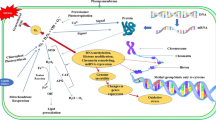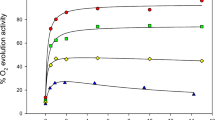Abstract
In plants of Mesembryanthemum crystallinum the activities of the two proton pumps on the tonoplast, i.e. the ATPase and the pyrophosphatase, and the gelelectrophoretic pattern of the total tonoplast proteins were analyzed during the transition of the metabolic state from C3 photosynthesis to Crassulacean acid metabolism (CAM). In one series, CAM was induced by watering the plants with NaCl. In another series, the change of the metabolic state to CAM was a consequence of the aging of the plants. No significant differences in the specific activities of ATP hydrolysis were found in plants performing C3 photosynthesis and CAM, respectively. However, with both series the protein content of tonoplast preparations and, in parallel, the total ATP hydrolytic activity of the tonoplast ATPase were higher after the change to CAM. In contrast, the specific activity of pyrophosphate hydrolysis was maximum in the preparations of young plants and diminished after the induction of CAM in both series. Therefore the tonoplast ATPase seems to be the main enzyme responsible for the energization of malate accumulation in CAM. The tonoplast pyrophosphatase is important in the early stages of plant growth and plays a minor role in CAM. With M. crystallinum the change from C3 photosynthesis to CAM is accompanied by de-novo synthesis of tonoplast proteins. Several polypeptides with relative molecular masses (Mrs) of 55, 41, and 36 kDa were clearly more pronounced in the gel-electrophoretic pattern of the total tonoplast protein after CAM induction. These changes were independent of the CAM-inducing salt treatment or aging. Moreover, two subunits of the tonoplast ATPase with Mrs of about 27 and 31 kDa showed particularly high intensities only in the CAM state. It is assumed that the subunit composition of the tonoplast ATPase differs in the two metabolic states and that the two subunits induced modify the regulation of the ATPase in CAM. In addition, the reaction of the plants to the NaCl treatment per se was the induction at the tonoplast of a polypeptide with an Mr of 24 kDa.
Similar content being viewed by others

Abbreviations
- CAM:
-
Crassulacean acid metabolism;
- Mr :
-
relative molecular mass
Referencess
Al-Awquati, Q. (1986) Proton translocating ATPases. Annu. Rev. Cell Biol. 2. (1986), 179–199
Aoki, K., Nishida, K. (1984) ATPase activity associated with vacuoles and tonoplast vesicles isolated from the CAM plant Kalanchoë daigremontiana. Physiol. Plant. 60, 21–25
Bowman, B.J., Bowman, J.E. (1986) H+-ATPases from mitochondria, plasma membranes, and vacuoles of fungal cells. J. Membr. Biol. 94, 83–97
Bremberger, C., Haschke, H.-P., Lüttge, U. (1988) Separation and purification of the tonoplast-ATPase and pyrophosphatase from plants with constitutive and inducible crassulacean acid metabolism. Planta 175, 465–470
Chanson, A., Pilet, P.E. (1987) Localization in sucrose gradients of the pyrophosphate-dependent proton transport of maize root membranes. Plant Physiol. 84, 1431–1436
Forgac, M. (1989) Vacuolar proton pumps. Physiol. Rev. 69, 765–796
Hohorst, H.-J. (1970) L-(-)-Malat, Bestimmung mit Malatdehydrogenase und NAD. In: Methoden der enzymatischen Analyse, vol. II, pp. 1544–1548, Bergmeyer, H.U., ed., Verlag Chemie, Weinheim
Hurkman, W.K., Tanaka, C.K., DuPont, F.M. (1988) The effects of salt stress on polypeptides in membrane fractions from barley roots. Plant Physiol. 88, 1263–1273
Jochem, P., Rona, J.-P., Smith, J.A.C., Lüttge, U. (1984) Anion sensitive ATPase-activity and proton transport in isolated vacuoles of species of the CAM genus Kalanchoë. Physiol. Plant. 62, 410–415
Klink, R., Haschke, H.-P., Kramer, D., Lüttge, U. (1989) Membrane particles, proteins and ATPase activity of tonoplast vesicles of Mesembryanthemum crystallinum in the C-3 and CAM state. Bot. Acta 103, 24–31
Laemmli, U.K. (1970) Cleavage of structural proteins during the assembly of the head of bacteriophage T4. Nature 227, 680–685
Lin, T.J., Morales, M.F. (1977) Application of a one step procedure for measuring inorganic phosphate in the presence of proteins: the actomyosin ATPase-system. Anal. Biochem. 77, 10–17
Lüttge, U., Ball, E. (1979) Electrochemical investigations of active malic acid transport at the tonoplast into the vacuoles of the CAM plant Kalanchoë daigremontiana. J. Membr. Biol. 47, 401–422
Lüttge, U., Smith, J.A.C., Marigo, G., Osmond, C.B. (1981) Energetics of malate accumulation in the vacuoles of Kalanchoë tubiflora cells. FEBS Letters 126, 81–84
Mandala, S., Taiz, L. (1986) Characterization of the subunit structure of the maize tonoplast ATPase. Immunological and inhibitor binding studies. J. Biol. Chem. 261, 12850–12855
Marquardt, G., Lüttge, U. (1987) Proton transporting enzymes at the tonoplast of leaf cells of the CAM plant Kalanchoë daigremontiana. II. The pyrophosphatase. J. Plant Physiol. 129, 269–286
Marquardt-Jarczyk, G., Lüttge, U. (1990) PPiase-activated ATPdependent H+-transport at the tonoplast of mesophyll cells of the CAM plant Kalanchoë daigremontiana. Bot. Acta 103, 203–213
Maslowski, P., Maslowska, H. (1987) Purification and some properties of proton-translocating pyrophosphatase from microsomal vesicles of corn seedlings. Biochem. Physiol. Pflanz. 182, 73–84
Montrichard, F., Pugin, A., Gaudemer, Y. (1989) Inhibition of the vacuolar ATPase of Acer pseudoplatanus cells by vanadate. Biochimie 71, 813–816
Moriyama, Y., Nelson, N. (1989) Lysosomal H+-translocating ATPase has a similar subunit structure to chromaffine granule H+-ATPase complex. Biochim. Biophys. Acta 980, 241–247
Oakley, B.R., Kirsch, D.R., Morris, N.R. (1980) A simplified ultrasensitive silver stain for detecting proteins in polyacrylamide gels. Anal. Biochem. 105, 361–363
Parry, R.V., Turner, J.C., Rea, P.A. (1989) High purity preparations of higher plant vacuolar H+-ATPase reveal additional subunits. J. Biol. Chem. 264, 20025–20032
Popov, N., Schmitt, M., Schulzek, S., Matthies, H. (1975) Eine störungsfreie Mikromethode zur Bestimmung des Proteingehaltes in Gewebehomogenaten. Acta Biol. Med. Ger. 34, 1441–1446
Rea, P.A., Sanders, D. (1987) Tonoplast energetization: Two H+pumps, one membrane. Physiol. Plant. 71, 131–141
Rea, P.A., Griffith, C.J., Manolson, M.F., Sanders, D. (1987) Irreversible inhibition of H+-ATPase of higher plant tonoplast by chaotrophic anions: evidence for peripheral location of nucleotid-binding subunits. Biochim. Biophys. Acta 904, 1–12
Sarafin, V., Poole, R.J. (1989) Purification of an H+-translocating inorganic pyrophosphatase from vacuole membranes of red beet. Plant Physiol. 91, 34–38.
Smith, J.A.C., Lüttge, U. (1985) Day-night changes in leaf water relations associated with the rhythm of crassulacean acid metabolism in Kalanchoë daigremontiana. Planta 163, 272–282
Struve, I., Weber, A., Lüttge, U., Ball, E., Smith, J.A.C. (1985) Increased vacuolar ATPase activity correlated with CAM induction in Mesembryanthemum crystallinum and Kalanchoë daigremontiana cv. Tom Thumb. J. Plant Physiol. 117, 451–468
Struve, I., Lüttge, U. (1987) Characteristics of MgATP2--dependent electrogenic proton transport in tonoplast vesicles of the facultative crassulacean-acid-metabolism plant Mesembryanthemum crystallinum L. Planta 170, 111–120
Struve, I., Lüttge, U. (1988) Biochemical and immunological properties of solubilized tonoplast ATPase of the facultative CAM plant Mesembryanthemum crystallinum in the C3 and CAM states. Bot. Acta 101, 39–44
Sze, H. (1985) H+-translocating ATPases: advances using membrane vesicles. Annu. Rev. Plant Physiol. 36, 175–208
Winter, K., von Willert, D.J. (1972) NaCl-induzierter CrassulaceenSäurestoffwechsel bei Mesembryanthemum crystallinum. Z. Pflanzenphysiol. 67, 166–170
Winter, K. (1973) CO2-Fixierungsreaktionen bei der Salzpflanze Mesembryanthemum crystallinum unter variierten Außenbedingungen. Planta 114, 75–85
Winter, K., Lüttge, U. (1979) C3-Photosynthese und CrassulaceenSäurestoffwechsel bei Mesembryanthemum crystallinum L.. Ber. Dtsch. Bot. Ges. 92, 117–132
Author information
Authors and Affiliations
Additional information
This work was supported by the Deutsche Forschungsgemeinschaft. J. Richter and R. Klink are thanked for their valuable cooperation in the preparation of, and experiments with, tonoplast vesicles. We thank Dr. R. Ratajczak (Institut für Botanik, TH Darmstadt, FRG) for valuable discussions about the manuscript.
Rights and permissions
About this article
Cite this article
Bremberger, C., Lüttge, U. Dynamics of tonoplast proton pumps and other tonoplast proteins of Mesembryanthemum crystallinum L. during the induction of Crassulacean acid metabolism. Planta 188, 575–580 (1992). https://doi.org/10.1007/BF00197051
Received:
Accepted:
Issue Date:
DOI: https://doi.org/10.1007/BF00197051



